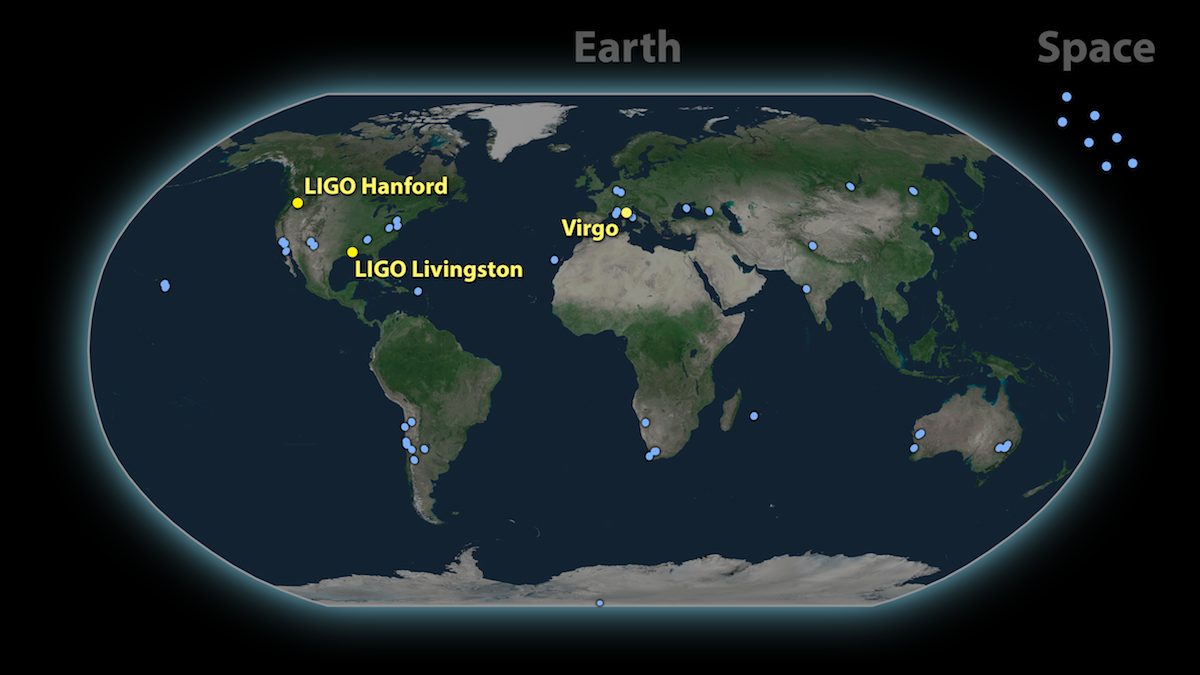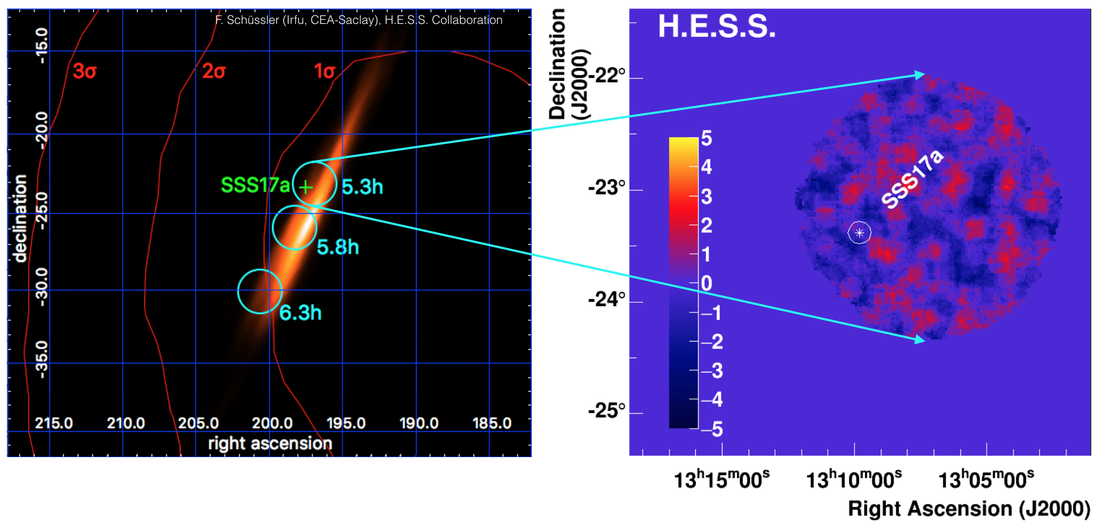|
On August 17, 2017, the gravitational wave interferometers Advanced Ligo and Advanced Virgo recorded a signal from the merger of a binary neutron star system, a type of signal that had never been seen before. Complementing this exciting discovery, a large variety of electromagnetic observations were able to record signals from the same event. They range from the detection of a gamma-ray burst about 2 seconds after the gravitational wave event, over near-infrared, optical and UV emission from decay of radioactive nuclei created in the resulting kilonova to X-ray and radio emissions detected several days and weeks after the event. This first and extremely successful observation campaign is marking the beginning of multi-messenger astrophysics. Observatories that participated in the observations following the detection of gravitational waves from the merger of a binary neutron star system. Can you spot H.E.S.S.? Source: LIGO/Virgo The gravitational wave event was localized within a region of about 30 square degrees, well beyond the H.E.S.S. field of view and requiring multiple pointings to cover the area. We (Monica, my PhD student and myself) rushed to apply the target selection algorithms that we had prepared and identified regions of high probability to find a counterpart of the gravitational wave event. We were able to request H.E.S.S. observations in record time (only 5minutes after the publication of the localisation of the gravitational wave event by Virgo/Ligo!!). Our observations thus started only 5.3h after the gravitational wave event GW170817. The covered regions already contained the counterpart SSS17a that has later been identified in the optical domain, several hours after our observations (see Figure below). As a result, H.E.S.S. was the first ground-based pointing instrument to obtain data on this object. A subsequent monitoring campaign with the H.E.S.S. telescopes extended over several days, covering timescales from 0.22 to 5.2 days and energy ranges between 270 GeV to 8.55 TeV. No significant gamma-ray emission has been found within this time interval. The derived upper limits on the very-high-energy gamma-ray flux for the first time constrain non-thermal, high-energy emission following the merger of a confirmed binary neutron star system, and further observations of this source will allow to check whether TeV energies are reached on a larger time scale. Left: Pointing directions of the first night of H.E.S.S. follow-up observations starting August 17, 2017, at 17:59 UTC. The circles illustrate a FoV with radius of 1.5 deg and the shown times are the starting times of each observation with respect to GW170817. The localisation map of GW170817 is shown as colored background, the red lines denote the uncertainty contours of GRB170817A. Right: Map of significances of the gamma-ray emission in the region around SSS17a obtained during the first H.E.S.S. observation of GW170817. The white circle has a diameter of 0.1deg, corresponding to the H.E.S.S. point spread function and also used for the oversampling of the map. Figure from Abdalla et al. (H.E.S.S. Collaboration), submitted to ApJL Following the observations, we rapidly transferred the data from Namibia to Europe for analysis. After some troubles due to hard-drives that were crushed during the shipping, we managed to carefully analyse the dataset in record time. In parallel we prepared a publication that (again in record time) has been submitted to ApJLetters right in time for the announcement of the gravitational wave event and the extensive follow-up campaign. The paper can be found on the arXiv tonight. For the very impatient ones it is already available on the H.E.S.S. website (incl. a short news article I wrote).
We also were able to contribute to a paper that has been prepared jointly by all observatories and collaborations contributing to these unprecedented observations. This paper can be found here: "Multi-messenger observations of a Binary Neutron Star Merger". It is definitely a milestone in astrophysics and will be regarded as the birth of multi-messenger astrophysics... After spending several years on the preparation of the H.E.S.S. multi-messenger program (see Multimessenger searches for more details), this event together with the multi-messenger and multi-wavelength observation campaign and the successful H.E.S.S. participation is extremely exiting and rewarding for my colleagues, friends and me personally... The dreams we were chasing for the last years (and that have been treated as such by many within the more main-stream astrophysics community) have suddenly materialized and become a reality. Exciting times ahead: the Virgo and Ligo interferometers are currently not taking data but are undergoing upgrades and further improvements. They should be restarting physics observations in summer 2018 with the prospect to detect many more events of this kind. After the frenzy of the weeks since the detection of GW170817, this break is obviously highly appreciated ;-) We'll also use it to further improve the response of high-energy gamma-ray instruments like H.E.S.S., CTA and HAWC to these events. You can even become part of this endeavor: see Team / open positions for details and don't hesitate to contact me (Contact). Exciting times ahead...
0 Comments
Leave a Reply. |
AuthorMyself ;-) Archives
January 2024
Categories
All
|


 RSS Feed
RSS Feed